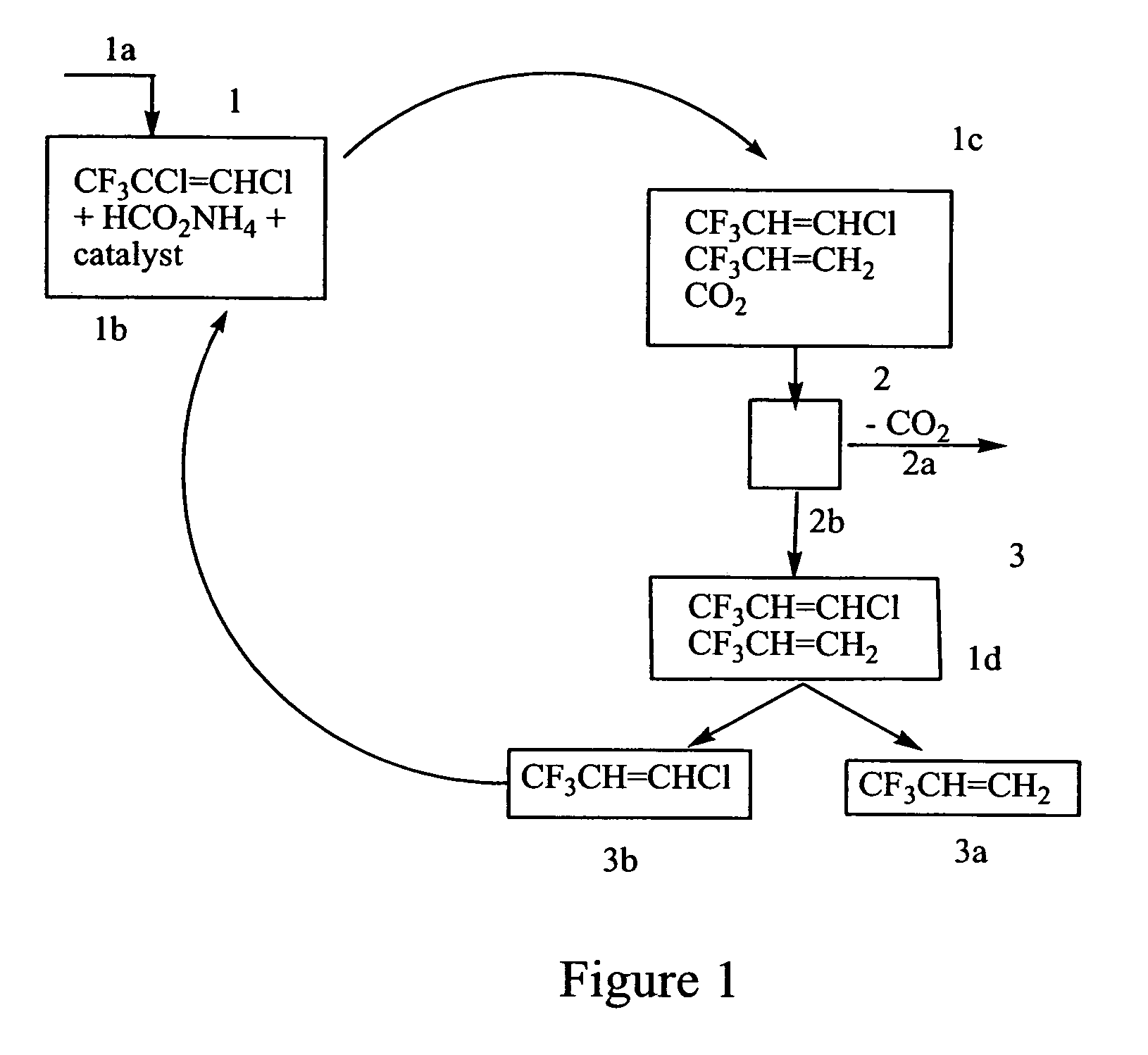Process for fluoroalkenes
a technology of fluoroalkene and process, which is applied in the field of preparation of fluoroalkene, can solve the problems of environmental unfriendly and economic inefficiency, the generation of one or more unwanted waste streams containing chlorinated products, so as to reduce the emission of environmental pollution and reduce the degree of chlorination
- Summary
- Abstract
- Description
- Claims
- Application Information
AI Technical Summary
Benefits of technology
Problems solved by technology
Method used
Image
Examples
example 1
Conversion of CF3—CH═CHCl (HCFC 1233) to CF3CH═CH2 (HFC 1243) with PdP(Ph3)4 Catalyst
[0037]A 250 mL Parr Reactor / autoclave was charged with 30 mL tetrahydrofuran to which 0.5 grams (0.04 mmol) [tetrakis(triphenylphosphine)palladium(0), [Pd(PPh3)4], 10.0 grams of ammonium formate (158 mmol), and 10.0 grams cold (5–10° C.) CF3CH═CHCl (77 mmol) were added under nitrogen. The reactor was sealed immediately, cooled to −30 to −40° C., and partially evacuated. The contents in the Parr reactor were brought to room temperature and gradually heated to 100° C. with stirring. The reactants were maintained at this temperature for 24 hours. During this time, the pressure in the reactor increased to approximately 180–200 psi. The reactor was then cooled to 25° C. and the volatile materials were collected in an evacuated metal cylinder.
[0038]Gas chromatographic (GC) analysis of the volatile materials indicated CF3CH═CH2 as the main product with trace amounts of CF3CH═CHCl and carbon dioxide. The re...
example 2
Conversion of CF3—CH═CHCl (HCFC 1233) to CF3CH═CH2 (HFC 1243) with Pd2(dba)3 Catalyst
[0039]A 250 mL Parr Reactor / autoclave was charged with 30 mL tetrahydrofuran (30 mL) to which 0.456 grams of tris(dibenzlideneacetone)dipalladium(0), Pd2(dba)3 (2.0 mmol), 0.8 grams of tributyl phosphine (2.0 mmol), 8.0 grams of ammonium formate (126 mmol), and 10.0 grams of cold (5–10° C.) CF3CH═CHCl (77 mmol) were added under nitrogen. The reactor was sealed immediately, cooled to −30 to −40° C., and partially evacuated. The contents in the Parr reactor were brought to room temperature, gradually heated to 100° C. with stirring. The reactants were maintained at this temperature for 24 hours during which the internal pressure rose to approximately 200 PSI. The reactor was then cooled to 25° C. and the volatile materials were passed through a trap at 70–78° C. and collected in a cold evacuated metal cylinder. Gas chromatographic (GC) analysis of the volatile materials collected indicated CF3CH═CH2 a...
example 3
Conversion of CF3—CH═CHCl (HCFC 1233) to CF3CH═CH2(HFC 1243) with Pd2(dba)3.CHCl3 Catalyst
[0042]The reaction was carried out as in Example 2 except that an equivalent amount of catalyst Pd2(dba)3 was substituted by tris(dibenzlideneacetone)dipalladium(0)chloroform complex, Pd2(dba)3.CHCl3. The extent of conversion of HCFC 1233 to CF3CH═CH2 was essentially the same as in Example 2.
PUM
| Property | Measurement | Unit |
|---|---|---|
| temperature | aaaaa | aaaaa |
| temperature | aaaaa | aaaaa |
| reaction time | aaaaa | aaaaa |
Abstract
Description
Claims
Application Information
 Login to View More
Login to View More - R&D
- Intellectual Property
- Life Sciences
- Materials
- Tech Scout
- Unparalleled Data Quality
- Higher Quality Content
- 60% Fewer Hallucinations
Browse by: Latest US Patents, China's latest patents, Technical Efficacy Thesaurus, Application Domain, Technology Topic, Popular Technical Reports.
© 2025 PatSnap. All rights reserved.Legal|Privacy policy|Modern Slavery Act Transparency Statement|Sitemap|About US| Contact US: help@patsnap.com



